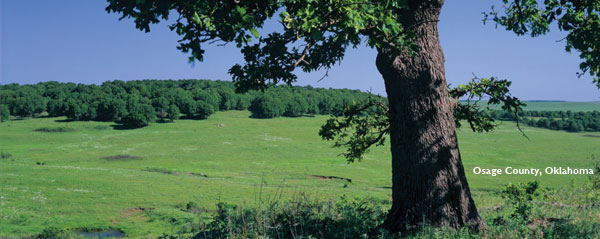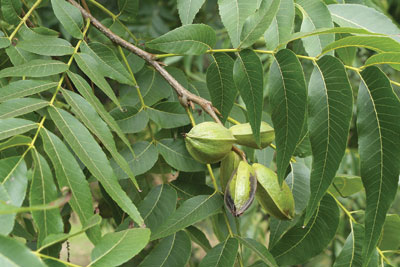|
back Home Cross TimbersGateway from forest to prairie Biodiversity of Oklahoma series |
|
Pecan
Carya illinoinensis
| Family: Juglandaceae (walnuts and hickories) Description: Tree to 20 m (65 ft) tall and 80 cm (30 in) diameter, with broad rounded crown and widely spreading branches when open-grown. Bark light brown to gray, becoming deeply and irregularly furrowed into scaly ridges on older trunks and branches. Twigs thick, gray-brown, becoming glabrous. The single terminal bud is grayish- or yellowish-hairy, narrow and flattened, with paired scales not overlapping. Leaves alternate, pinnately compound, 30-50 cm (12-20 in) long, with a usually hairy rachis. Leaflets usually 11-17, lanceolate, 5-18 cm (2-7 in) long, acuminate, finely serrate, glabrous yellow-green above, paler below, the lower leaflets usually curved or sickle-shaped. Flowers catkins appearing in the early spring. Fruits oblong, 3-5 cm (1.2-2 in) long, with thin husk splitting along four raised ridges. The seeds are delicious and nutritious, and are eaten by people and numerous species of wildlife. Distribution: It is difficult to determine the "natural" range of the species, since it was an important food source for Native Americans and was planted as far away as central Mexico in pre-Columbian times. Habitat: well-drained floodplains (extensively planted in uplands) NWI status: FAC+ Comment: The nuts of all the hickories are important food for wildlife, especially squirrels. Pecan is an important crop plant across the southern U. S., and is widely planted as a shade tree in towns. Carya is the ancient Greek name for walnut; illinoinensis refers to Illinois, where the species was first described. From the Catalog of the Woody Plants of Oklahoma by Johnson & Hoagland. |
|
|
back to species list |
PDF of all species profiles
|

